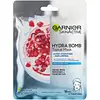What's inside
What's inside
 Key Ingredients
Key Ingredients

 Benefits
Benefits

 Concerns
Concerns

 Ingredients Side-by-side
Ingredients Side-by-side

Water
Skin ConditioningNiacinamide
SmoothingPropanediol
SolventDipropylene Glycol
Humectant1,2-Hexanediol
Skin ConditioningHydroxyacetophenone
AntioxidantTrehalose
HumectantGlycerin
HumectantSodium Acrylic Acid/Ma Copolymer
Butylene Glycol
HumectantDisodium EDTA
Carbomer
Emulsion StabilisingArginine
MaskingOctyldodeceth-16
EmulsifyingXanthan Gum
EmulsifyingCaprylyl Glycol
EmollientGlycine
BufferingGlutamic Acid
HumectantCentella Asiatica Extract
CleansingMadecassoside
AntioxidantAspartic Acid
MaskingAnthemis Nobilis Flower Extract
MaskingPortulaca Oleracea Extract
Skin ConditioningGluconolactone
Skin ConditioningSodium Polyacrylate
AbsorbentSodium Chloride
MaskingResveratrol
AntioxidantCentella Asiatica Flower/Leaf/Stem Extract
Skin ConditioningCentella Asiatica Leaf Extract
Skin ConditioningCentella Asiatica Root Extract
Skin ConditioningSaccharomyces Ferment
Skin ConditioningHistidine
HumectantSerine
MaskingAlanine
MaskingThreonine
Proline
Skin ConditioningAcrylates/C10-30 Alkyl Acrylate Crosspolymer
Emulsion StabilisingAsiaticoside
AntioxidantMagnesium Chloride
Calcium Chloride
AstringentAloe Barbadensis Leaf Juice
Skin ConditioningAsiatic Acid
Skin ConditioningMadecassic Acid
Skin ConditioningParfum
MaskingWater, Niacinamide, Propanediol, Dipropylene Glycol, 1,2-Hexanediol, Hydroxyacetophenone, Trehalose, Glycerin, Sodium Acrylic Acid/Ma Copolymer, Butylene Glycol, Disodium EDTA, Carbomer, Arginine, Octyldodeceth-16, Xanthan Gum, Caprylyl Glycol, Glycine, Glutamic Acid, Centella Asiatica Extract, Madecassoside, Aspartic Acid, Anthemis Nobilis Flower Extract, Portulaca Oleracea Extract, Gluconolactone, Sodium Polyacrylate, Sodium Chloride, Resveratrol, Centella Asiatica Flower/Leaf/Stem Extract, Centella Asiatica Leaf Extract, Centella Asiatica Root Extract, Saccharomyces Ferment, Histidine, Serine, Alanine, Threonine, Proline, Acrylates/C10-30 Alkyl Acrylate Crosspolymer, Asiaticoside, Magnesium Chloride, Calcium Chloride, Aloe Barbadensis Leaf Juice, Asiatic Acid, Madecassic Acid, Parfum
Water
Skin ConditioningPropylene Glycol
HumectantGlycerin
HumectantAlcohol
AntimicrobialP-Anisic Acid
MaskingDipotassium Glycyrrhizate
HumectantGlyceryl Acrylate/Acrylic Acid Copolymer
HumectantHamamelis Virginiana Leaf Water
AstringentHydrogenated Starch Hydrolysate
HumectantHydroxyacetophenone
AntioxidantHydroxyethylcellulose
Emulsion StabilisingLimonene
PerfumingMannose
HumectantPEG-40 Hydrogenated Castor Oil
EmulsifyingPhenoxyethanol
PreservativePotassium Hydroxide
BufferingPotassium Sorbate
PreservativePunica Granatum Fruit Extract
AntioxidantPvm/Ma Copolymer
Emulsion StabilisingSodium Benzoate
MaskingSodium Hyaluronate
HumectantSorbic Acid
PreservativeXanthan Gum
EmulsifyingParfum
MaskingWater, Propylene Glycol, Glycerin, Alcohol, P-Anisic Acid, Dipotassium Glycyrrhizate, Glyceryl Acrylate/Acrylic Acid Copolymer, Hamamelis Virginiana Leaf Water, Hydrogenated Starch Hydrolysate, Hydroxyacetophenone, Hydroxyethylcellulose, Limonene, Mannose, PEG-40 Hydrogenated Castor Oil, Phenoxyethanol, Potassium Hydroxide, Potassium Sorbate, Punica Granatum Fruit Extract, Pvm/Ma Copolymer, Sodium Benzoate, Sodium Hyaluronate, Sorbic Acid, Xanthan Gum, Parfum
 Reviews
Reviews

Ingredients Explained
These ingredients are found in both products.
Ingredients higher up in an ingredient list are typically present in a larger amount.
Glycerin is already naturally found in your skin. It helps moisturize and protect your skin.
A study from 2016 found glycerin to be more effective as a humectant than AHAs and hyaluronic acid.
As a humectant, it helps the skin stay hydrated by pulling moisture to your skin. The low molecular weight of glycerin allows it to pull moisture into the deeper layers of your skin.
Hydrated skin improves your skin barrier; Your skin barrier helps protect against irritants and bacteria.
Glycerin has also been found to have antimicrobial and antiviral properties. Due to these properties, glycerin is often used in wound and burn treatments.
In cosmetics, glycerin is usually derived from plants such as soybean or palm. However, it can also be sourced from animals, such as tallow or animal fat.
This ingredient is organic, colorless, odorless, and non-toxic.
Glycerin is the name for this ingredient in American English. British English uses Glycerol/Glycerine.
Learn more about GlycerinHydroxyacetophenone is antioxidant with skin conditioning and soothing properties. It also boosts the efficiency of preservatives.
This ingredient is not irritating or sensitizing.
Parfum is a catch-all term for an ingredient or more that is used to give a scent to products.
Also called "fragrance", this ingredient can be a blend of hundreds of chemicals or plant oils. This means every product with "fragrance" or "parfum" in the ingredients list is a different mixture.
For instance, Habanolide is a proprietary trade name for a specific aroma chemical. When used as a fragrance ingredient in cosmetics, most aroma chemicals fall under the broad labeling category of “FRAGRANCE” or “PARFUM” according to EU and US regulations.
The term 'parfum' or 'fragrance' is not regulated in many countries. In many cases, it is up to the brand to define this term.
For instance, many brands choose to label themselves as "fragrance-free" because they are not using synthetic fragrances. However, their products may still contain ingredients such as essential oils that are considered a fragrance by INCI standards.
One example is Calendula flower extract. Calendula is an essential oil that still imparts a scent or 'fragrance'.
Depending on the blend, the ingredients in the mixture can cause allergies and sensitivities on the skin. Some ingredients that are known EU allergens include linalool and citronellol.
Parfum can also be used to mask or cover an unpleasant scent.
The bottom line is: not all fragrances/parfum/ingredients are created equally. If you are worried about fragrances, we recommend taking a closer look at an ingredient. And of course, we always recommend speaking with a professional.
Learn more about ParfumWater. It's the most common cosmetic ingredient of all. You'll usually see it at the top of ingredient lists, meaning that it makes up the largest part of the product.
So why is it so popular? Water most often acts as a solvent - this means that it helps dissolve other ingredients into the formulation.
You'll also recognize water as that liquid we all need to stay alive. If you see this, drink a glass of water. Stay hydrated!
Learn more about WaterXanthan gum is used as a stabilizer and thickener within cosmetic products. It helps give products a sticky, thick feeling - preventing them from being too runny.
On the technical side of things, xanthan gum is a polysaccharide - a combination consisting of multiple sugar molecules bonded together.
Xanthan gum is a pretty common and great ingredient. It is a natural, non-toxic, non-irritating ingredient that is also commonly used in food products.
Learn more about Xanthan Gum